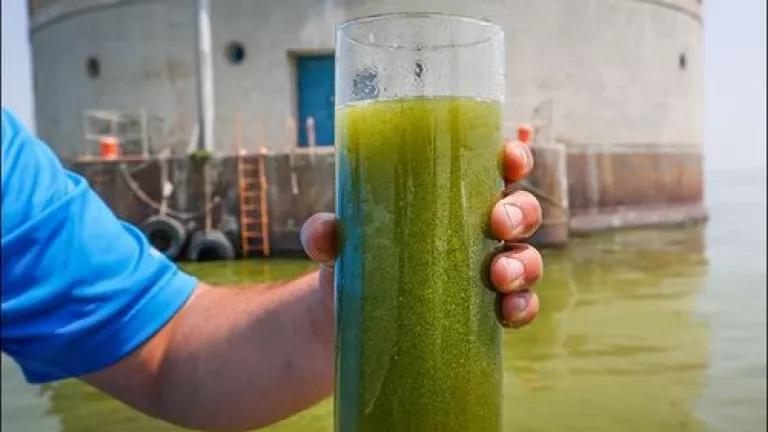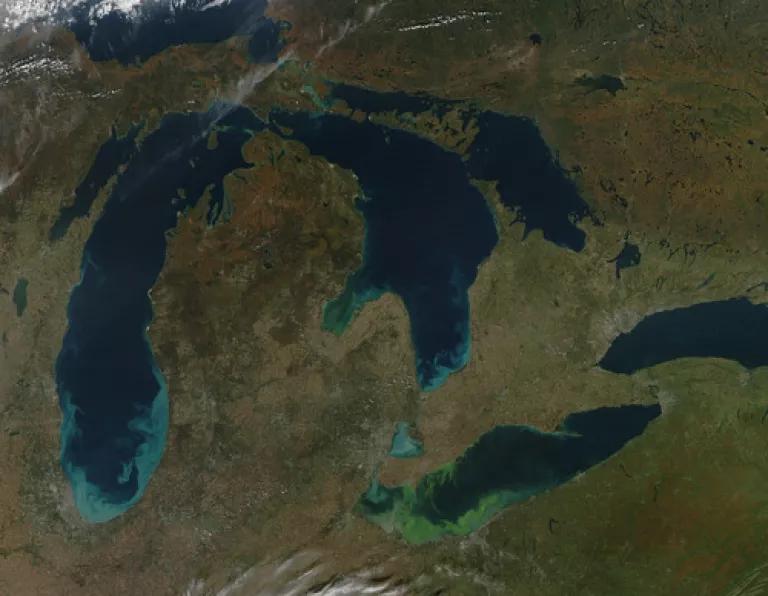Conference in Ohio to Discuss Algal Toxins, But Effects of Changing Climate Should Also Be on the Agenda

Can you imagine not being able to drink water from your own sink for three days, instead having to get it from a nearby fire station because it is unsafe? Last summer Toledo residents didn't have to imagine this nightmare, they lived it during a drinking water ban spurred by a toxic algal surge in Lake Erie.
And when it comes to trying to clean up these chronic algal bloom problems, which also plague other states--like Michigan--and other cities--like Des Moines--decisionmakers need all the help they can get.
Photo Courtesy of The Blade/Dave Zapotosky
These blooms of green slime feed off the fertilizer pollution from sources like agricultural runoff and sewage treatment flowing into rivers and eventually into Lake Erie. The crisis is becoming more urgent as climate change warms our waters and increases the frequency and severity of storms, which fuel the toxic algal blooms.
This week, University of Michigan scientists are presenting at Ohio's Bowling Green State University on their ongoing research to determine what exactly is causing the cyanobacteria that shut the taps off in Toledo last summer to become so toxic -while other bacteria do not.
This is important work. But more needs to be done to address another key question--how do we tackle climate change?--which is a prominent factor in the blooms that the Ohio State University predicts will become more and more the norm as the planet warms.
Climate Action Must be Part of the Long-Term Plan
To be sure, the sources of the algae bloom are multifaceted. They include an array of water pollution sources (see the suite of blogs posted last summer by NRDC's Midwest Program staff, including Karen Hobbs and Rob Moore). But it is clear that worsening climate change impacts will continue to exacerbate the issue: more violent storms flush ever-more fertilizer-laden runoff into the Lake, while its shallow waters are warmed, making it more susceptible to the algae blooms at the heart of Toledo's water woes. If we allow climate change to advance, we will see more of this type of situation.
This isn't my assertion--it follows prescient research from the Ohio State University released just one month before last summer's contaminated drinking water crisis.
The crisis is by no stretch of the imagination new; after all, the algae blooms could be seen from space covering half the lake a couple years ago. And in the year prior to the last bloom, the New York Times declared that "Lake Erie is sick," noting that climate change--in addition to agricultural runoff--is a major contributor to this growing problem.

Photo courtesy of the NASA Goddard Space Flight Center
But what remains surprising is just how little the role of climate action has been considered as decision-makers clamber for answers.
To Fix This Multi-Faceted Problem We Need Multi-Faceted Solutions.
While the Ohio General Assembly passed legislation last month that may start to address the excessive agricultural runoff fueling the blooms, a longer-term action plan needs to be developed that reduces the worst impacts of climate change.
We need our elected officials to act now.
The first, most obvious step would be to reverse last spring's ill-advised clean energy policy freeze and re-assert our commitment to attracting robust investment in energy efficiency and renewables right here in Ohio. It is now well-known that these clean energy policies are an important part of the calculus to cut carbon and start to tackle the root cause of climate change.
We hope these points make their way into the discussion at Bowling Green State University this week. We'll also be talking about ways to incorporate more clean energy at the fourth stop on the Ohio Energy Future Tour on April 27th in Toledo.
